Calving Preparedness
It is officially spring when calves start hitting the ground. There are a few reminders, tips, and tricks that everyone should revisit, even the seasoned veterans of calving. It’s amazing the things you can still learn, or forget you have learned, no matter how long you’ve been in the business.

First and foremost, there’s equipment and supplies you want to make sure you have on hand when calves start hitting the ground
- Calving pen & head-gate if possible
- Chains & chain handles
- Calf Jack (if comfortable using)
- OB Lube & OB gloves
- Towels & antiseptic
- Flashlight
- Trailer – accessible and in operating condition
Also, ask yourself, do you have a protocol in place for what to do if something isn’t quite right with a cow/heifer? Knowing what to check for, when to call for help, and who to call isn’t something that should be figured out at the last minute. Be sure to post this information in an easily accessible place, especially if not everyone checking on the cows is a veteran farmer. Oftentimes there are spouses, kids, neighbors, and friends that all help, so having everyone on the same page is beneficial.
Finally, there are 3 stages to calving. The first stage of calving can start as early as 2 weeks prior to the actual date the calf presents to the world. It consists of gradual changes such as relaxation and swelling of the vulva (“springing”) and the loss of the cervical plug. The second stage signals that calving is impending in approximately the next 24 hours. Here we see the relaxing of the pelvic ligaments, strutting of the teats, and behavior changes such as isolation and decreased feed intake. Stage three is when “calving” actually starts. Once this starts there should be constant progress of the calf to the outside world. If there isn’t that constant progress, there is a problem. Heifers get a little more leniency since they have never experienced this before, so give them about an hour before intervention/checking as long as there are no obvious problems. Cows are usually quicker – if they haven’t calved in about 30 minutes or at least made continuous progress, they will likely need some intervention.
No matter how long we’ve been working with calves, there is always something new and strange that can happen that we can never be fully prepared for. Reviewing and preparing ahead of time can help make life a bit easier and help ensure that some of the more common/routine things don’t become a problem. Remember – if there are ever any questions or help is needed, we have someone available 24/7 to help! Just give us a call!
